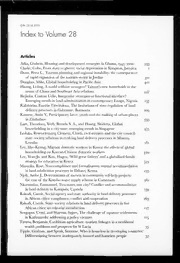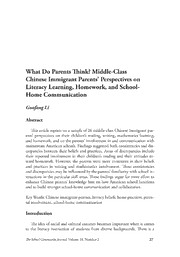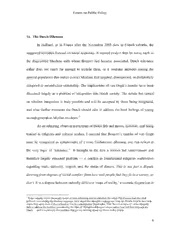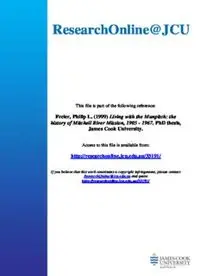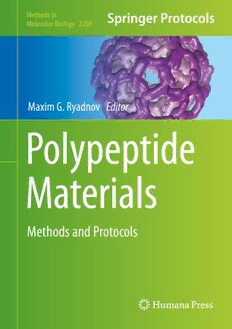
Polypeptide Materials: Methods and Protocols PDF
Preview Polypeptide Materials: Methods and Protocols
Methods in Molecular Biology 2208 Maxim G. Ryadnov Editor Polypeptide Materials Methods and Protocols M M B ETHODS IN OLECULAR IO LO GY SeriesEditor JohnM.Walker School of Lifeand MedicalSciences University ofHertfordshire Hatfield, Hertfordshire, UK Forfurther volumes: http://www.springer.com/series/7651 For over 35 years, biological scientists have come to rely on the research protocols and methodologiesinthecriticallyacclaimedMethodsinMolecularBiologyseries.Theserieswas thefirsttointroducethestep-by-stepprotocolsapproachthathasbecomethestandardinall biomedicalprotocolpublishing.Eachprotocolisprovidedinreadily-reproduciblestep-by- step fashion, opening with an introductory overview, a list of the materials and reagents neededtocompletetheexperiment,andfollowedbyadetailedprocedurethatissupported with a helpful notes section offering tips and tricks of the trade as well as troubleshooting advice. These hallmark features were introduced by series editor Dr. John Walker and constitutethekeyingredientineachandeveryvolumeoftheMethodsinMolecularBiology series. Tested and trusted, comprehensive and reliable, all protocols from the series are indexedinPubMed. Polypeptide Materials Methods and Protocols Edited by Maxim G. Ryadnov National Physical Laboratory, Teddington, Middlesex, UK Editor MaximG.Ryadnov NationalPhysicalLaboratory Teddington,Middlesex,UK ISSN1064-3745 ISSN1940-6029 (electronic) MethodsinMolecularBiology ISBN978-1-0716-0927-9 ISBN978-1-0716-0928-6 (eBook) https://doi.org/10.1007/978-1-0716-0928-6 ©SpringerScience+BusinessMedia,LLC,partofSpringerNature2021 Thisworkissubjecttocopyright.AllrightsarereservedbythePublisher,whetherthewholeorpartofthematerialis concerned,specificallytherightsoftranslation,reprinting,reuseofillustrations,recitation,broadcasting,reproduction onmicrofilmsorinanyotherphysicalway,andtransmissionorinformationstorageandretrieval,electronicadaptation, computersoftware,orbysimilarordissimilarmethodologynowknownorhereafterdeveloped. Theuseofgeneraldescriptivenames,registerednames,trademarks,servicemarks,etc.inthispublicationdoesnotimply, evenintheabsenceofaspecificstatement,thatsuchnamesareexemptfromtherelevantprotectivelawsandregulations andthereforefreeforgeneraluse. Thepublisher,theauthors,andtheeditorsaresafetoassumethattheadviceandinformationinthisbookarebelievedto betrueandaccurateatthedateofpublication.Neitherthepublishernortheauthorsortheeditorsgiveawarranty, expressedorimplied,withrespecttothematerialcontainedhereinorforanyerrorsoromissionsthatmayhavebeen made.Thepublisherremainsneutralwithregardtojurisdictionalclaimsinpublishedmapsandinstitutionalaffiliations. CoverIllustrationCaption:Aself-assembledpeptidicvirus-likecapsid.CourtesyofIreneMarzuoliandFrancaFraternali. ThisHumanaimprintispublishedbytheregisteredcompanySpringerScience+BusinessMedia,LLC,partofSpringer Nature. Theregisteredcompanyaddressis:1NewYorkPlaza,NewYork,NY10004,U.S.A. Preface This volume continues the misson of the book series to provide the research community with a systematic overview of contemporary research methods in the area of molecular biology. The volume details the synthesis and assembly of polypeptide materials (proteins andpeptides),theirprecursors,conjugates,andderivatives.Aparticularemphasisismadeon themeasurementtoolsandproceduresfor materialcharacterization,bothphysicochemical and functional. Often overlooked in the literature, such a focus can address the growing demand for improving reproducibility in biomedical research. It can also help to better reflect the interdisciplinary nature of molecular biology and the importance of developing innovativemeasurementmethodstoadvancethearea.Writtenasstep-by-stepinstructions, protocols in this volume are not limited to the given examples and are applicable to other materialsofthesameandsimilartypes.Thisisalsomeanttohelpthereadertokeepabreast with achievements beyond the scope of each topic avoiding both generalization, which wouldotherwiseomitimportantnuancesinmeasurementresults,e.g.,sourcesofvariation, andinstantiation,whichwouldnarrowthemdowntospecialistcases. The volume opens with a protocol for the chemical synthesis of peptide thioesters. Theseareroutinelyusedasbuildingblocksforcomplexstructuresrangingfromproteinsto advanced functional materials (Raz and Offer). Traditional approaches toward peptide thioesters use highly hazardous chemistries, which are increasingly problematic to imple- mentinthemodern,risk-averselaboratorypractice,whereasalternativeroutescontinueto suffer from poor reproducibility, giving products of low purity and yields. All of this is addressed in the first chapter that describes a shortcut methodology to peptide thioesters, whichcanenablepost-synthesisapplicationssuchasnativechemicalligation.Unlikechemi- cal methods, which require achieving optimum stoichiometry, native peptide–peptide liga- tions may proceed to completion at nearly equimolar ratios of ligating fragments. These reactionsareself-catalyzed,whiletheirefficiencycanbeimprovedusinganauxiliarymeans suchasconformationallydrivenligationsthatbringligatingendsincloseproximityallowing the two components to fuse even at low concentrations. An example of these reactions is given in the following chapter, which offers a straightforward method for peptide–peptide ligation (Buldun et al.). The method termed SnoopLigase conjugation facilitates the site- specificfusionofproteinsviatheformationofanisopeptidebondwith>95%efficiency.The described strategy relies on the use of peptide tags and has already been demonstrated to enhanceenzymeresilienceandtheefficacyofvaccinesthroughantigenoligomerization.The protocol details a range of conditions for SnoopLigase reactions together with optimized purification steps for the ligated products and the quantification of ligation efficiency. The keyadvantagesofthismethodarehighligtedtoincludethemaximumconversionofreacting components,lowconcentrations used,andprecisetaglocationwhichprovetobeeffective eveninside cells. Both thechapters advocate for covalent conjugatesas preferable forms of peptidematerials.Thisholdstrueformany.Forother technologiesofbiologicalrelevance, covalent modifications may not be necessary or even prohibitive, while both covalent and non-covalent macromolecular systems are equally common. Gene therapy is one of such application areas. Its main purpose is to deliver functional genetic material into the cell. Genes, be these RNA or DNA, cannot traverse cellular membranes by themselves and requireacarrier vehicletomediatethetransfer.Avarietyofpeptideswithsimilarproperties v vi Preface have been shown to provide suitable packaging systems for various nucleic acids and oligonucleotidesalike. The next two chapters describe protocols for the preparation and characterization of non-covalent gene packaging systems. Gomez et al. make stress on nanoparticle formula- tionsresultingfromcell-penetratingpeptidesthatcaneithercondenseorencapsulatesmall interferenceRNA(siRNA)andDNA.Theprotocolisexemplifiedbyanumberofcommer- cial and experimental reagents and provides an exhaustive workflow for their preparation and analysis including peptide synthesis, purification, efficiency and stability of particle formation, and intracellular uptake. Welch et al. follows upon this chapter with nanoparti- culate formulations of siRNA enabled by condensation with bespoke disulfide-constrained cyclic peptides. The peptides act as a switch system that opens up in the reducing environ- ments of the cell and is degraded by proteases releasing siRNA into the cytoplasm. This protocol details a step-by-step preparation of the formulation, from synthesis to siRNA complexation, and ramps up the biological validation of peptide packaging systems of this type to animal model experiments, demonstrating effective gene knowdown, which con- firmstherelevanceandapplicabilityofnon-covalentpeptidesystemsinvivo.Thenatureof forces that drive nanoparticle formation is not specifically addressed in these two chapters. Nevertheless, for all the systems described, conformational changes are involved in com- plexation,intracellular uptake,andrelease.Insomecases,thechangesareadirectresultof bindingtonucleicacids;inothers,itisthefoldingofpeptidesthatmediatesthecomplexa- tionorpredeterminesencapsulation. Complementary to this, Chapter 5 reports quantitative examples of conformationally drivenfunctionsmediatedbyproteinsandpeptides(Shiuetal.).Thisprotocoldescribesthe protein-triggered opening of a nanoscale box assembled using the principles of DNA origami.TheconstructionoftheDNAboxisdetailedinlinewiththefunctionalassessment of the opening process that is monitored by Fo¨rster resonance energy transfer (FRET). Lactate dehydrogenase from Plasmodium falciparum specifically binds to a DNA aptamer servingasa“lock”inthebox.Whenthetargetproteinbindstotheaptamer,theboxopens, whichleadstoachangeinFRETsignal.Alltheprocessessupportingthemethodologyare mediated by highly specific molecular recognition events between biological materials of differentchemistries.Exploitingsucheventsfordevelopingandstudyingfunctionalmateri- alsisthesubjectofthefollowingchapter whichbroadenstheapplicationofconformational changes to the behavior prediction of self-assembling systems (Marzuoli and Fraternali). This chapter presents detailed guidelines for molecular dynamic simulations of biological nanoscalesystemswithaparticularemphasisontheirhierarchicalnature.Thelatterisneatly matched with force fields used in simulations, which are categorized according to the accuracy and speed they offer. Each force field is assigned to a specific type of simulation, thus probing the pros and cons of their prediction power in comparison, and to a specific hierarchicaltypeofbiologicalassemblyascomplexasproteincages. Experimentalprotocolsinemulating,predicting,andexploitingtheproteinshellarchi- tecture are given in the next four chapters. Chapter 7 (Inaba and Matsuura) describes nanocapsulate assembly of protein shells from β-annulus peptides. These peptides derive fromnaturallyoccuringvirusessuchastomatobushystuntvirusandrepresentastructurally conserved topology allowing for symmetric assembly into spherical hollow nanoparticles. The protocol details all aspects of their production and analysis starting with peptide synthesis protocols. Conjugations and non-covalent decorations of the assembled particles withDNA,metalnanoparticles,andpeptidesarealsodiscussed.Bothexterior(surface)and interior (encapsulation) functionalizations are presented, rendering this design one of the Preface vii mostcharacterizeddiscretesystemsreportedtodate.Thenextchapter(Chakrabortietal.) takesadifferentapproachwithaprotocoldescribingtheuseofproteincagesinconstructing regulararraysofmetalnanoparticles.Themethodologyusesthesameprinciplesofelectro- staticinteractions,butinsteadofencapsulatingmetalparticlesincagesordecoratingcages with a metal corona, this approach employs the interactions to build three-dimensional (3D)geometricobjects,inwhichproteincagesandmetalparticlesalternateformingsuper- lattices. Protein cages with biological activities may present an obvious choice for design. Thisiscoveredinthefollowingprotocol(Tarasovetal.),whichdescribessyntheticanalogs of a portion of a transmembrane domain of G-protein-coupled receptors (GPCR). The analogsaredesignedtoassembleintovirus-likeparticlesretaininganintrisicGPCRinhibi- toryactivity.Themethodologytakesastructure-baseddesignroutetoimplementboththe functions,biological and self-assembly, in theconstituent monomer of theparticles.Com- prehensive instructions are provided for the structure, design, synthesis, assembly, and physicochemical characterization of the particles. The final chapter in this quartet (De Santis and Ryadnov) continues this direction with a protocol for imaging and 3D reconstruction of virus-like particles using high-resolution and cryogenic electron micros- copy. Unlike examples used in previous chapters, these particles are de novo capsids con- structed without prior structural information. Designed from scratch, the capsids need ultrastructural elucidation to support and improve the design principles. Therefore, this protocol provides major steps in the structural analysis of the particles as a continuum of measurementprocedures,fromassemblyto3Dreconstruction. Virus-likeparticlesrepresentoneofthemajornanomaterialmorphologiesthatfinduse invariousapplicationsandshowconsistentprogressinnewdesignsandthedevelopmentof bespokemethodologiestoadvancetheprecisionandaccuracyofanalysis.Sincemost,ifnot all, proteinand peptide nanoscale materials rely onself-assembly processes, methodologies thatareabletomonitortheprocessesinrelationtoresultingmorphologiesareofparticular interest.Inthisregard,thenextprotocoldesribestheapplicationoftime-resolvedemission spectroscopy to track the protein assembly exemplified by fibrillogenesis (Alghamdi et al.). Proteinfilamentsconstituteanother major nanomaterialmorphology,whichcanalsobeof natural and synthetic origin. The protocol is built around case studies for both types and extends measurements to post-assembly events such as aggregation, with relevance to pathological processes including amyloidosis. The method follows changes in fluorescence as a function of time, which gives a continuous measure of growth kinetics and, when applicable,aggregation(e.g.,conversionofamyloidfibrilstoplaques).Representativetime- resolvedspectrawithdatainterpretationarealsodiscussedtodemonstratetheadvantagesof themethodology. Thereexistsasubtleborderlinebetweenthedifferentoutcomesofpeptideassemblyand aggregation. The former assumes a higher level of control to enable the fabrication of reproducible materials that deliver the desired functions. The rate and type of assembly is defined at the primary structure level but can also be directed by external stimuli and fabrication methods. An exemplar method is described in the next chapter (Cross et al.). This protocol focuses on the fabrication and characterization of nanostructured hydrogel materials. Typically designed to support 3D cell culture, both in vitro and in vivo, peptide hydrogels result from the formation of 3D filamentous networks. Filamentous assembly does not necessarily lead to gelation. Therefore, successful hydrogel designs are often complemented with effective fabrication methods. The protocol provides an additional valueofproducinghydrogelsindifferentforms—thinfilmspreparedinsecondsandthicker gels prepared in minutes. Protein assembly is initiated within 1 h, but can mature to an viii Preface equilibrium phase in a few hours. Monitoring nanomaterial formation under assembly conditions from the outset is important and is of particular interest if it allows to probe sizechanges.Suchchangesareauniversalindicatornotonlyforthegrowthkineticsbutalso for the quality of the produced material as they can inform preventive measures against undesiredprogessions,e.g.,aggregation. Dynamiclightscatteringisacommontoolforsizemeasurements,withyetlimiteduse due to the requirements of using large sample volumes and low throughput. These chal- lengesareaddressedintheprotocolbyKwanetal.,whichdescribesdynamiclightscattering measurements executed in a fully automated fashion for low-volume samples and in solu- tion, i.e., in situ. The protocol offers a generic pre-screening method for downstream structural studies of polypeptide and other biomolecular materials using higher-resolution approachesincludingX-raycrystallography,electronmicroscopy,small-angleX-rayscatter- ing,andNMR.Sinceinmostcasesnanoscalepeptidematerialsareproducedunderaqueous conditions,solutionmeasurementsremainaprerequisitefor theircharacterization.Finally, assembledproductscanbeusedunderdifferentconditions,whichnecessitatethedevelop- ment of other specialist methods and protocols. Peptide coatings are increasingly relevant forapplicationswhereaccuratecontrolover thickness,homogeneity,anddensityisimpera- tive.X-rayphotoelectronspectroscopyoffersoneofthemostinformativemethodstoprobe theseproperties.Thistechniqueishighlysensitivetochangesonsurfacesprovidingquanti- tativeinformationonthechemicalcompositionofmaterialswithin10-nmdepthsfromtheir surfaces.Theuseofthismethodforflatand3Dsubstrates(e.g.,nanoparticulatematerials)is detailed in the protocol by Cant et al. Surface analysis approaches are explored for more complex measurements aiming to characterize different events and under different conditions. Atomic force microscopy (AFM) has revolutionalized the area of protein assembly at interfacesandisrapidlyprogressingtowardlivecellandhigh-speedmeasurementsofvarious biologically relevant meachanims mediated by peptide materials (Hammond et al.). This development is characteristic of a timely and complementary response to advances in material designs and biotechnologies that demand more precise mechanistic investigations in native and near-native environments. Broader developments concern microscopy cap- abilities as a whole. One drive here is to enable correlative imaging of the same biological processes or systems using microscopy modalities that differ by imaging speed, resolution, andsamplesize.Correlativeimagingisviewedasanultimatesolutiontothecharacterization of nanoscale materials in cellular media. AFM is one of such modalities. It can cover the nano-to-micrometer length scale but has limitations in depth resolution and screening throughput. Other approaches lack the resolution of AFM but can support high- throughput measurements, ensuring statistically significant analysis of cell populations, while being able to support single-cell measurements. A highly effective strategy is to empower optical fluorescence microscopy with microfluidic devices such as one described in the penultimate protocol of the volume (Cama and Pagliara). Here, a single chip of thousands of micro-channels can accommodate thousands of individual cells whose response to peptide treatment can be imaged over a set period of time. This allows kinetic measurements of cell responses (growth and lysis) as well as concentration-dependent peptide–cell interactions. Exemplified by antimicrobial effects of peptide materials on bac- terial phenotypes, the strategy is adaptable to other cell-based measurements including processesthatseeknewinsightsattheintracellularlevel.However,revealingorconfirming the details at this level demands much higher resolution, whereas the number of available modalities is limited. Encouragingly enough, ultramicrotomy analysis of peptide-treated Preface ix cells using electron microscopy proves to provide access to critical information at highest resolution possible today. Described in the last chapter by Rey et al., this methodology provides a step-by-step instruction for sample preparation and processing, imaging and analysisofbacterialandmammaliancellsfollowingpeptidetreatment.Furthermore,exam- ples of intracellular infections and their targeting by bespoke peptide materials is also discussed, thus culminating this volume with arguably the most challenging and complex applicationmeasurementofpeptidematerialsatthenanoscale. Teddington,Middlesex,UK MaximG.Ryadnov
The list of books you might like

Rich Dad Poor Dad

The 48 Laws of Power

The Sweetest Oblivion (Made Book 1)

Mind Management, Not Time Management
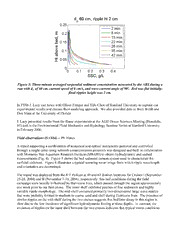
DTIC ADA523737: Sand Ripple Dynamics on the Inner Shelf

Amazon Rekognition - Developer Guide
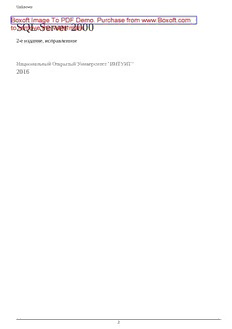
SQL Server 2000
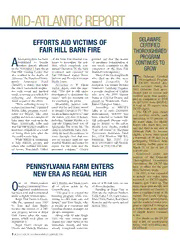
Mid-Atlantic Thoroughbred January 2006

O Egito Antigo

Bölüm Oku

The Georgia Historical Quarterly 1993: Vol 77 Index

Bölüm Oku

Bülten No 32 - Ocak 2014
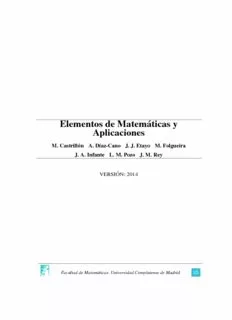
Elementos de Matemáticas y Aplicaciones
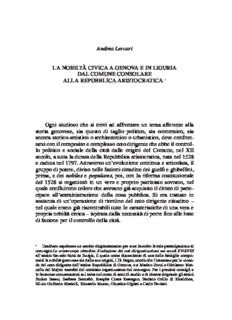
Andrea Lercari LA NOBILTÀ CIVICA A GENOVA E IN LIGURIA DAL COMUNE CONSOLARE ALLA

The Mentor No 41 Famous Composers by Henry T Finck
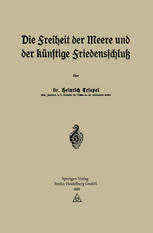
Die Freiheit der Meere und der Künftige Friedensschluß
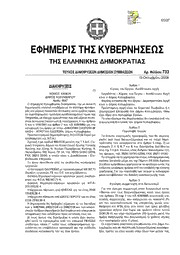
Greek Government Gazette: Part 7, 2006 no. 733
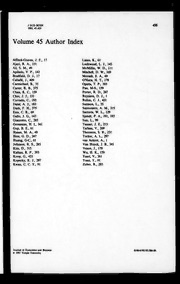
Journal of Economics and Business 1993: Vol 45 Index

